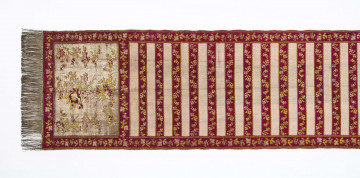
One-sided kontusz belt
1766 — 1788
National Museum in Lublin
Part of the collection: Textiles, embroideries, clothing and costume accessories of the 16th–19th c.
The custom of wearing belts made of expensive silk fabrics, often interwoven with gold or silver (solid), came to Poland from the East. From the 16th century, they were imported mainly by Armenians from India, Persia and Turkey. Oriental fashion, and with time the native tradition of wearing a robe, contributed to the emergence of many belt factories, i.e., sash manufactories, in the Republic of Poland. Armenians also initiated the establishment of such weaving manufactories.
The most significant demand for sash manufactories occurred during the Great Sejm period. It was then that Paschalis Jakubowicz, previously known as the owner of a Turkish shop offering oriental products, set up a weaving workshop.
He came to Poland from Anatolia in the 1860s. He was a daring and enterprising merchant. In 1788, he established his first workshop and employed many weavers. Initially, he operated in Warsaw, then at his estate in the nearby Lipków. The demand for robe belts exceeded his production capacity, so he ordered the goods in the country (mainly in Kraków) or imported them from Lyon. His belts were signed with the name Paschalis embossed in the four corners of the heads. In 1790, he was ennobled in recognition of his merits 'for multiplying useful handicrafts'. From then on, he began to sign his products with the initials PI or his full name – Paschalis Jakubowicz, and the coat of arms representing a lamb with a flag. Such marking guaranteed buyers that the product came from a reputable source and was of excellent quality. Jakubowicz did not stop importing products from Lyon at that time. When the quality of the fabrics deteriorated, the owner of a highly valued persimmon factory, unwilling to sign poor quality fabrics with his initials, gave them up. The solid robe belt in the Lublin collection, with decoration referring to the best Słuck patterns, is noteworthy and testifies to the highest quality of Paschalis Jakubowicz's fabrics.
Magdalena Norkowska
Author / creator
Dimensions
cały obiekt: height: 360 cm, width: 35 cm
Object type
a contoured belt
Technique
weaving
Material
silk (natural fabric), gold metal thread, silver metal thread
Creation time / dating
Creation / finding place
Owner
The National Museum in Lublin
Identification number
Location / status

1766 — 1788
National Museum in Lublin

1767 — 1780
National Museum in Lublin

1781 — 1806
National Museum in Lublin
DISCOVER this TOPIC
Museum of King Jan III's Palace at Wilanów
DISCOVER this PATH
Educational path